After ending the 2019/20 campaign in second place on the Ligue 1 table, trailing only Paris Saint-Germain, and earning a place in the UEFA Champions League for the current campaign, Olympique de Marseille now sit in sixth place in Ligue 1, at the time of writing, with four teams between them and league leaders PSG.
Les Olympiens have been enduring some problems of late in what has been described as a ‘tumultuous’ run of form, winning just one of their last eight Ligue 1 games, so it’s clear that not all is perfect at Orange Vélodrome right now.
In this tactical analysis piece, in the form of a scout report, we’ll provide some analysis of the standout statistics and elements of manager André Villas-Boas’ tactics to highlight areas of improvement for the Provence-Alpes-Côte d’Azur-based club, so that they may be able to turn their dismal run of form around and get back on track with their pursuit of securing a Champions League place for a second consecutive campaign.
Marseille must be more clinical
Les Olympiens have got the sixth-lowest xG (26.67) in France’s top-flight for the 2020/21 campaign at present, which provides a fairly stark contrast to last season when they ended the campaign with the sixth-highest xG in Ligue 1 (37.27).
However, Marseille’s xG-per-shot is far more impressive. They have got the fourth-highest xG-per-shot (0.145) of any Ligue 1 team for the 2020/21 campaign at present.
Their relatively low overall xG provides us with an indication as to why they’ve scored just 27 goals so far this term – the 11th-best goalscoring record of any Ligue 1 side, and not one that you might immediately associate with a Champions League-qualification place contender.
This, combined with their relatively high xG-per-shot, however, paints an even clearer picture. Generally speaking, the goalscoring opportunities that Marseille have created this season have been of fairly high quality but they’ve failed to create many of them. As a result, when they’ve not been clinical enough with the good chances they’ve created, they’ve been punished.
Darío Benedetto slightly overperformed on his xG last season, indicating that throughout the campaign, he scored more goals than would be expected based on the quality of chances he was presented.
This season, the centre-forward, who has started 17 of Marseille’s 19 Ligue 1 games so far this term and featured in all 19 games, is underperforming on his xG to a significant extent, however.
Per Wyscout, Benedetto has got an xG of 0.47-per-90 for the 2020/21 league season right now, while he’s scored an average of 0.26 goals-per-90. So, he’s almost scored half as many goals as you’d expect, based on the chances he’s had.
Les Olympiens’ main centre-forward underperforming to this extent highlights that they haven’t been clinical enough but he’s not the only offender in the squad, he just provides a good example. Teammates of his, such as Florian Thauvin, Michaël Cuisance, Marley Aké and Saif-Eddine Khaoui have all underperformed on xG also.
Marseille miss Payet’s long-shots
It’s clear that Villas-Boas wants his side to prioritise getting into the best-possible goalscoring positions before taking a shot, more often than not, rather than just shooting on sight, however, that might take one of their best tools – Dimitri Payet’s long-shots – out of their game.
You could undoubtedly argue that the goal of creating high-quality chances at the expense of long-shots can be a very sensible one. However, when their main centre-forward, who is on the receiving end of the majority of those chances, hasn’t been clinical enough and the team is losing games, a decision has to be made – do you stick with those tactics and hope that Benedetto turns things around, or do you take a different approach?
One negative to Villas-Boas’ tactics this season, other than how heavily they rely on the players being clinical, is that they result in Marseille losing out on the long-shot threat that is Payet.
Last season, Marseille were far happier to shoot from distance. They ended the 2019/20 campaign having taken the second-highest number of shots outside of the penalty area of any team in Ligue 1.
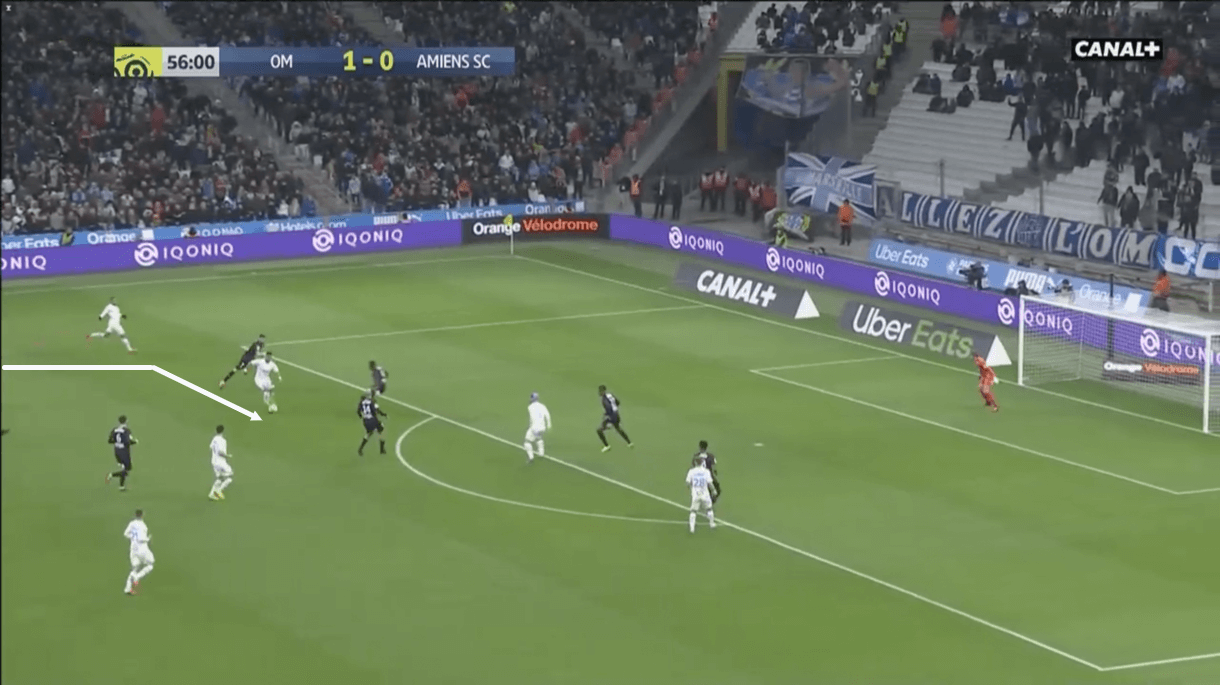
With 40 to his name, Payet took twice as many shots from outside of the box as any other Marseille player, so it’s clear that they relied heavily on this element of his game and it produced results, as he ended the season as Marseille’s second-highest goalscorer, with nine. The image above, taken from the 2019/20 campaign, shows us an example of the type of position in which the playmaker loved to get into. This was shooting-range for Payet.
This season, however, Marseille have taken by far the lowest number of shots from outside the area of any Ligue 1 side (65) and Payet has taken just six, which is fewer than five other Marseille players, including Florian Thauvin, who was injured for the 2019/20 campaign and has taken the most long-shots of any Marseille player this term (13).
On returning to Marseille’s first-team setup following his injury woes of last season, you could argue that Thauvin has replaced Payet as the main creator in Marseille’s team.
In terms of assists, Thauvin has already got seven to his name, which is more than Payet (four) managed last term. Thauvin has also scored six league goals already this season, with Payet, who has scored three goals this term, managing to hit the back of the net on nine occasions in Ligue 1 in the 2019/20 campaign.
Additionally, per Understat, Thauvin has accumulated an impressive xGChain (total xG of every possession the player is involved in) of 11.4 at this stage in the campaign, indicating how central he has been to Villas-Boas’ system this term.
Payet ended the 2019/20 campaign with the highest xGChain of any Marseille player, and it was 11.01, which is lower than Thauvin’s at this stage of the 2020/21 season.
Thauvin’s rise to prominence within this setup goes hand-in-hand with Villas-Boas’ switch to rely more on creating high-quality goalscoring chances than attempting a relatively high amount of long-shots.
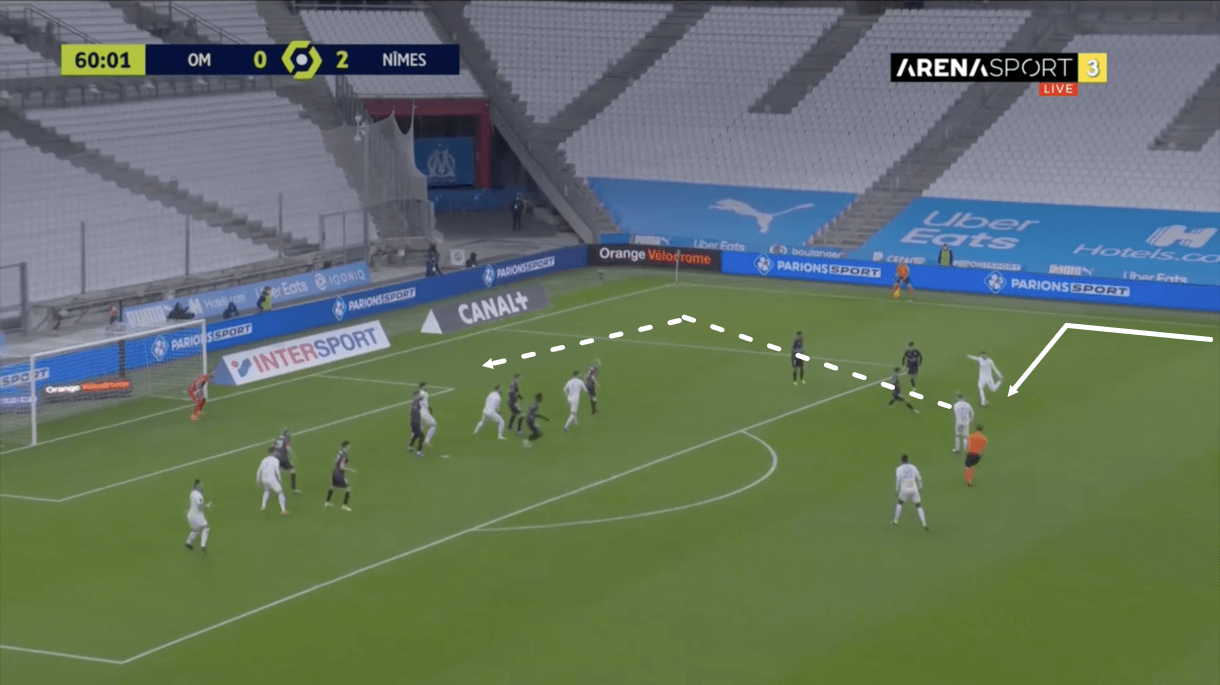
Thauvin takes far fewer long-shots than Payet, he prefers to get into positions like the one we can see him occupying above, which is similar to the position we saw Payet occupying in the previous image, and play a cross/attempted key pass, rather than take a shot.
Getting Thauvin into these positions is a key element of Marseille’s game and as a result, he has still taken the most long-shots of any Marseille player this term, but he’s on course to take far fewer than Payet did when he played a similar role inside the attacking third last season.
This is a significant difference between Thauvin and Payet. Perhaps this explains why Thauvin has been more central to Marseille’s system this term than Payet. This has been successful in terms of getting the most out of Thauvin, as he has already produced as many goal contributions as Payet produced last season.
However, despite taking far more long-shots, Payet’s shot accuracy was almost identical last season to what it is this season. He ended last season with a shot accuracy of 43.33%, while he has currently got a shot accuracy of 43.75% for the 2020/21 campaign.
This may indicate that Payet wasn’t particularly wasteful when shooting from range, as his shot accuracy wasn’t noticeably worse despite taking far more long-shots, while his goalscoring record was significantly better, indicating that this may have been a useful element to Marseille’s game last season and something they’re missing this season.
Marseille must stop giving deep turnovers
Marseille’s defensive performance has been respectable this season. They have got the sixth-lowest xGA (24.65) of any Ligue 1 side, while they’ve got the joint-fifth-best defensive record in terms of goals conceded, having conceded on just 22 occasions in the league this season.
They could potentially be faring even better on this front, however, with some glaring defensive weaknesses of Marseille’s rearing their heads on multiple occasions during the 2020/21 campaign. This has led to Les Olympiens conceding some goals that they will be kicking themselves about, however, oftentimes goals are conceded more as a result of your own mistakes, rather than opposition brilliance.
That has certainly been the case a lot of the time for Marseille this season, particularly in the Champions League, where they finished bottom of their group, conceding 13 goals in six games. Now, we’ll highlight some mistakes and weaknesses that have hurt Villas-Boas’ side at the back this term, beginning with their tendency to give the ball away deep, allowing the opposition to spring a counter-attack from a dangerous, advanced position.
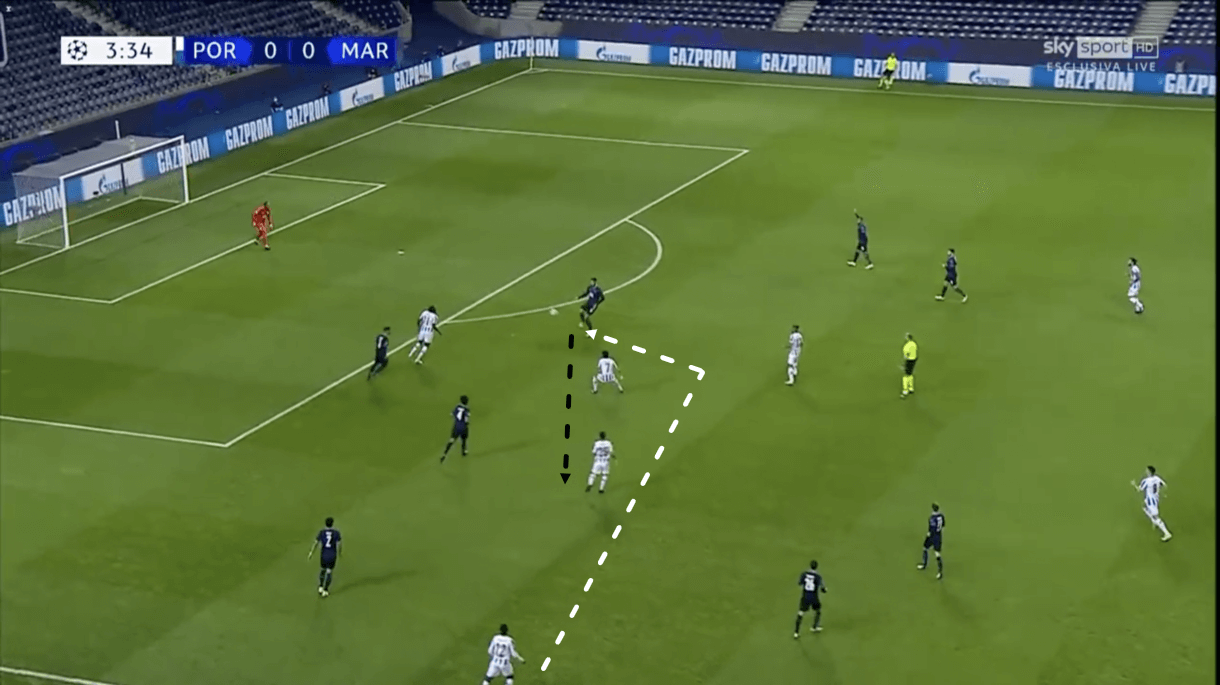
We can see an example of one such occasion where this happened in the image above. Here, Duje Ćaleta-Car can be seen getting on the receiving end of a cross attempt from the opposition.
As he makes contact with the ball, however, he doesn’t clear it upfield, nor does he take it down and take more time to assess the situation, instead, he immediately volleys it back out to the opposition, but with very little power on it, so the ball finds an opposition attacker just outside the box.
It would seem as though Ćaleta-Car were trying to play the ball to his teammate, Boubacar Kamara, just alongside this player, but his pass was wayward and resulted in the opposition springing a counter from just outside the box which led to a goal.
Villas-Boas prefers his defenders to try and play their way out of trouble, however, at times this season, a lack of quality and some poor decision-making has been apparent amongst Marseille’s defence, leading to events like this, where the ball is given away fairly cheaply in a very dangerous position. Marseille have conceded several goals as a result of this exact type of situation this season. It’s seemingly an issue of quality and/or decision-making a lot of the time which lets Villas-Boas down.
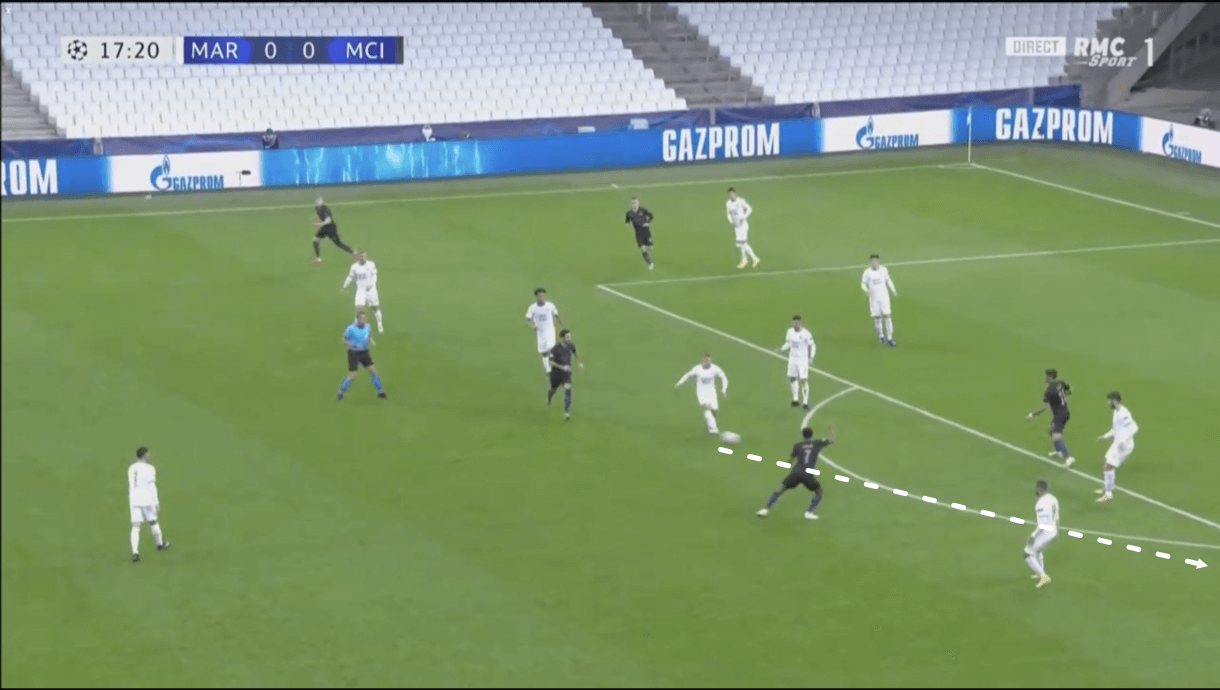
We can see another example of this type of scenario in the image above. Here, midfielder Valentin Rongier can be seen in possession, carrying the ball out from the back, beginning a counter-attack for Marseille. However, as he does so, he opts to play the ball backwards, across his own goal and the pass fails to find the intended target, Ćaleta-Car, as the pass is misdirected, with too much pace on it.
This allows none other than Manchester City’s Kevin De Bruyne to pounce, with the Belgian playing the ball across the box for Phil Foden to finish.
That passage of play, again, highlights some poor decision-making which cost Marseille the opening goal in a Champions League game that they would go on to lose 3-0. If Villas-Boas can help his side to make fewer of these little errors when playing out from the back, they would undoubtedly see some significant benefits.
At present, their error-proneness is a notable area of weakness for them and perhaps it would be sensible for teams to utilise some aggressive tactics off the ball, as Man City did, to try and exploit this weakness.
Back-post crosses
Marseille have also conceded several goals to back-post crosses this term. Les Olympiens tend to defend with a very narrow back-four and this sees their full-backs, usually Hiroki Sakai at right-back and one of either Jordan Amavi or Yuto Nagatomo at left-back, defending crosses aimed at the back-post.
This is something that opposition teams have utilised to their advantage this season, with these full-backs struggling to deal with aerial balls on many occasions, while Marseille centre-back Álvaro González has also struggled to defend in the air versus aerially-strong attackers at times this term.
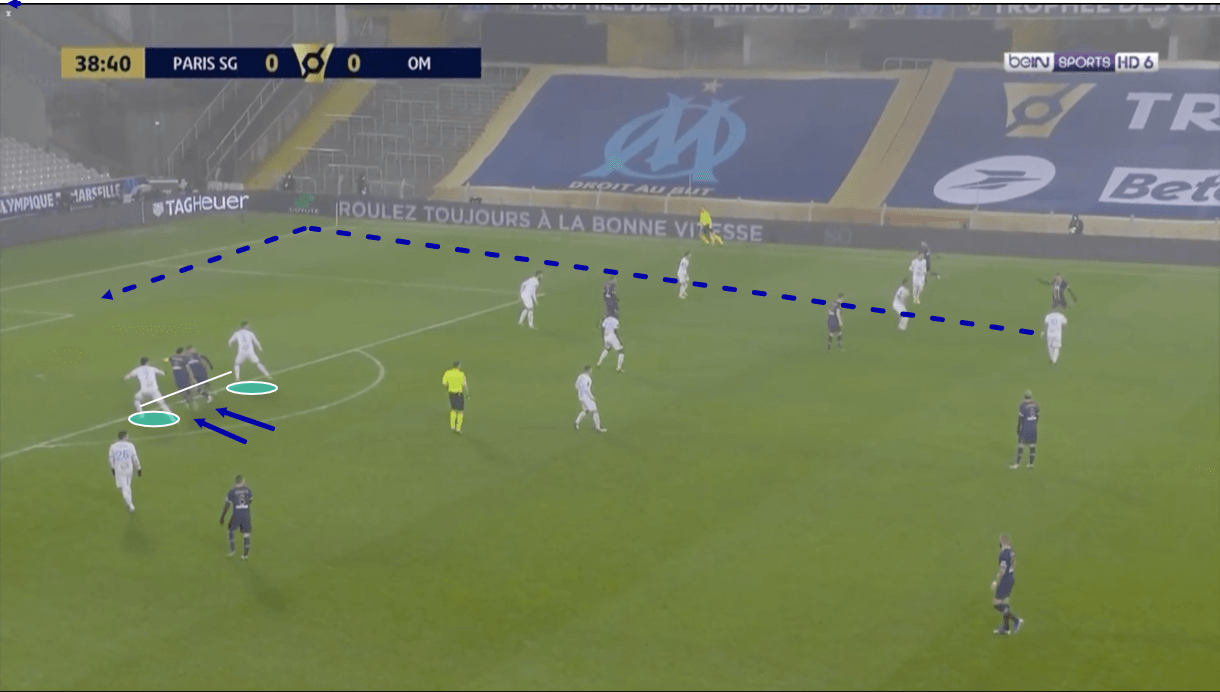
The image above, taken from Marseille’s 2-1 Trophée des Champions loss to PSG earlier this month, shows us one example of this weakness in Marseille’s defence of coping with back-post crosses being exploited via a deep cross and some intelligent movement from the attackers.
One important thing to note, as this deep cross is being played into the box by PSG, is the positioning of Marseille centre-back González and right-back Sakai, both of whom are circled in the image.
Just moments before this image was taken, centre-forward Mauro Icardi peeled off the shoulder of González and began to dart forward into the box behind the centre-back but still a significant distance in front of the right-back, who was separated from the striker by PSG captain Marquinhos, who is also very high up the pitch here, adding an aerial threat to his side’s attack, sitting on right-back Sakai.
Looking at the position of Sakai, in relation to Marquinhos, the Marseille right-back is also clearly not in a great position to deal with the cross potentially reaching the Brazilian, with Marquinhos making his run in front of the Marseille man and only goalkeeper Steve Mandanda between him and the back of the net, similar to Icardi. Sakai is essentially playing catch-up as soon as the ball is played into the box, he never manages to get square to Marquinhos or Icardi or get between the PSG men and the goal, and ultimately Marseille pay the price.
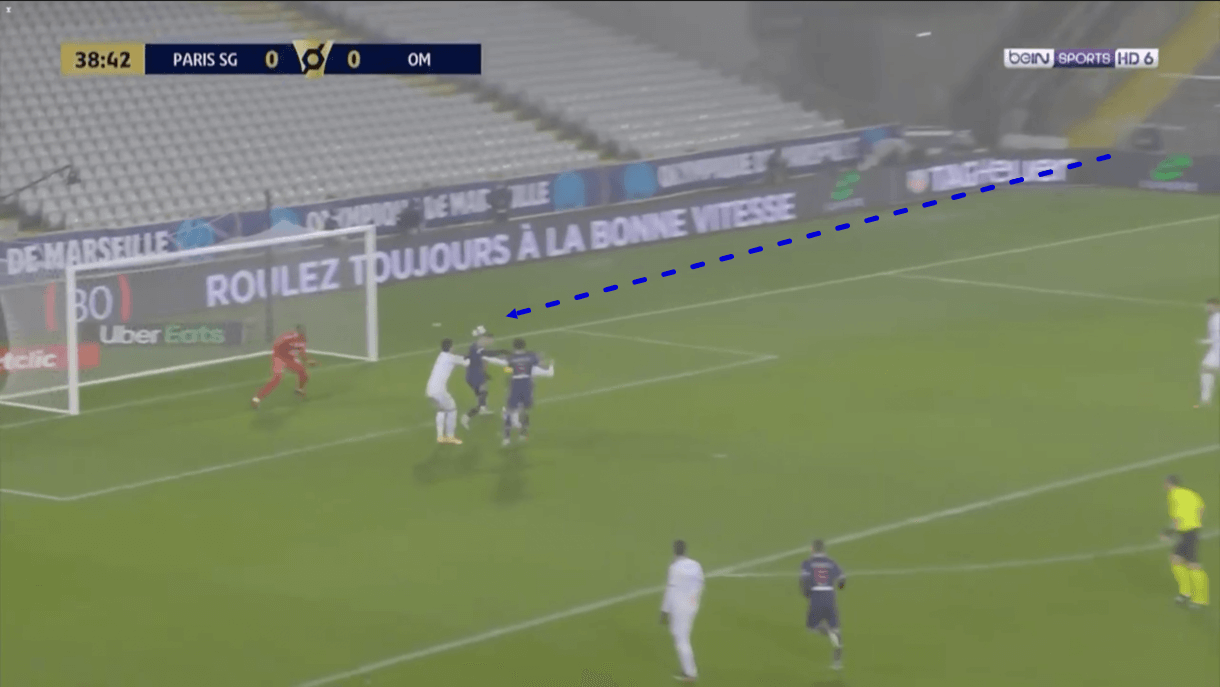
As the play moves on, we see that Icardi met the cross, forced a save from Mandanda and followed up to put the ball in the back of the net, opening the scoring for PSG in a game that Les Parisiens would go on to win 2-1.
It may have been a wise and calculated move from PSG to send the ball to the back-post like this, as Marseille have conceded plenty of goals, both at the left and right side, as a result of crosses being played to the back post this term. It’s an area that some teams have seemingly targeted to a degree of success and so, perhaps this is one area that Villas-Boas should look at when it comes to improving his team defensively, to potentially prevent more teams from exploiting this weakness.
Conclusion
To conclude this tactical analysis piece, It’s clear that Villas-Boas and Marseille have got plenty of areas of improvement, both in and out-of-possession, which, if focused on, could help them to end their poor run of form and get their eyes back on closing the gap between them and PSG.
Marseille will need to get better at taking their chances to succeed playing how Villas-Boas wants, and perhaps the signing of Arkadiusz Milik will help them to do that, while they also might be able to get more out of Payet, as they did last season, to make themselves more of a threat in offence.
On the defensive side of things, seemingly minor errors and areas of weakness being exploited are adding up and costing Marseille big this season, and if they can reduce their errors in decision-making, positioning etc at the back, then surely the second half of the season would be more positive than the first.


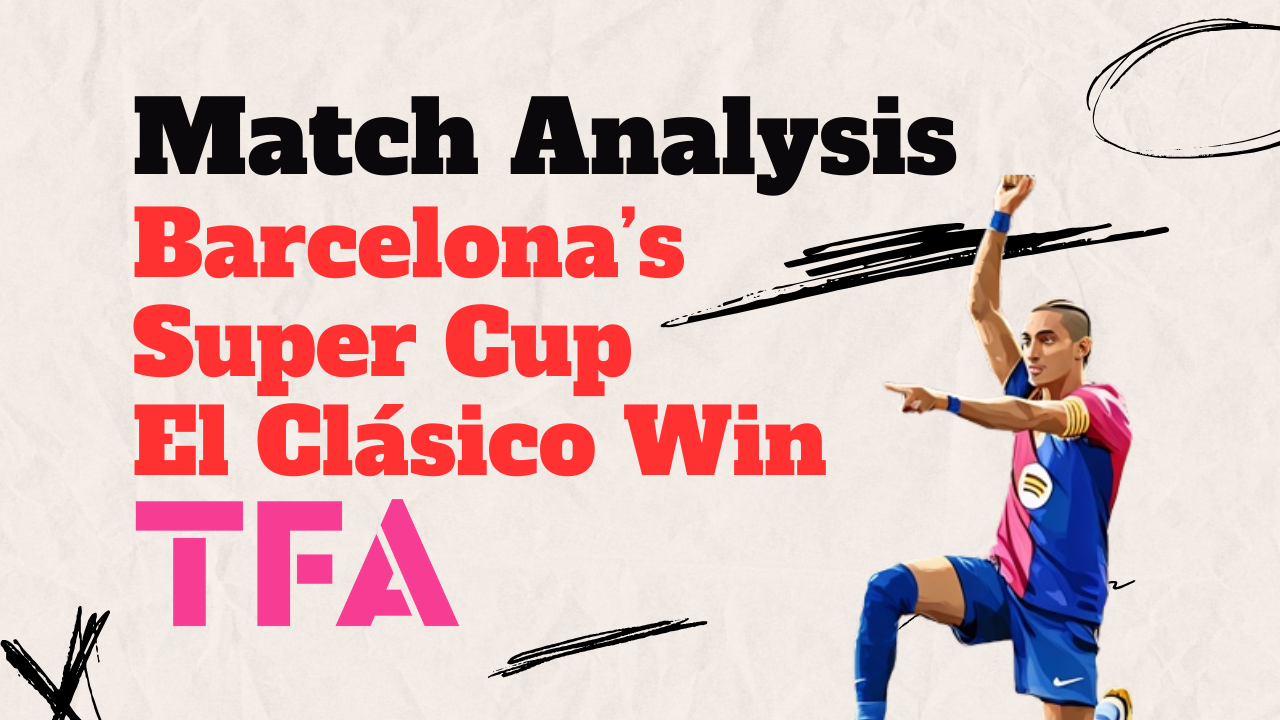
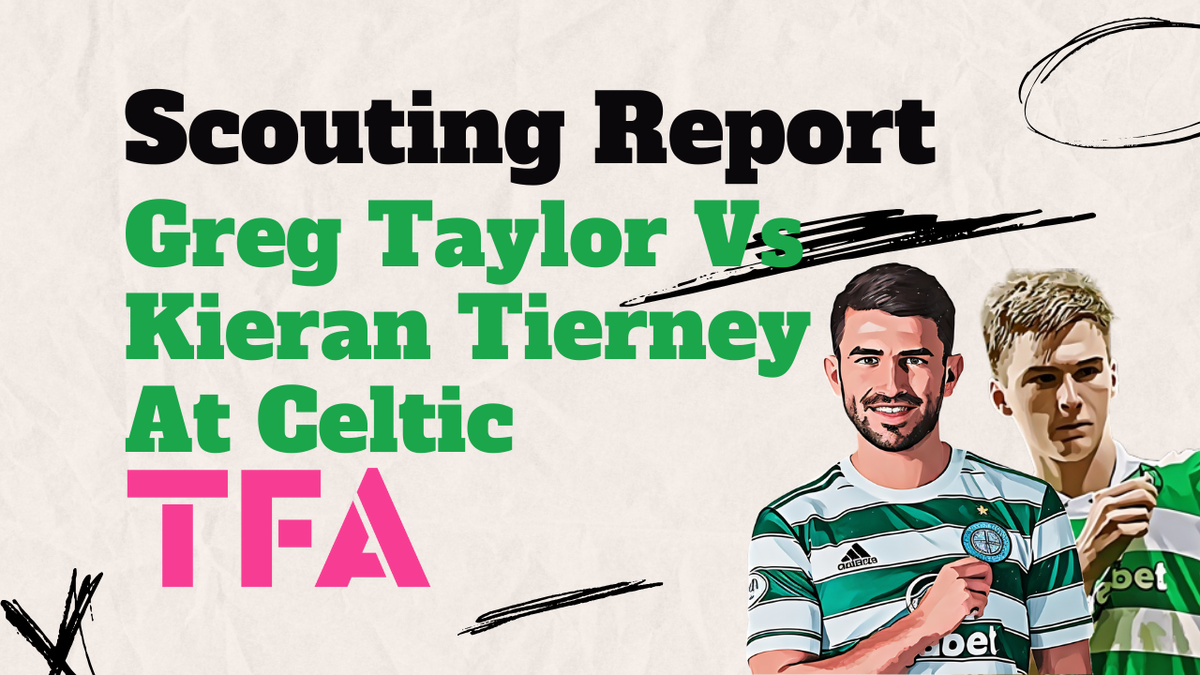
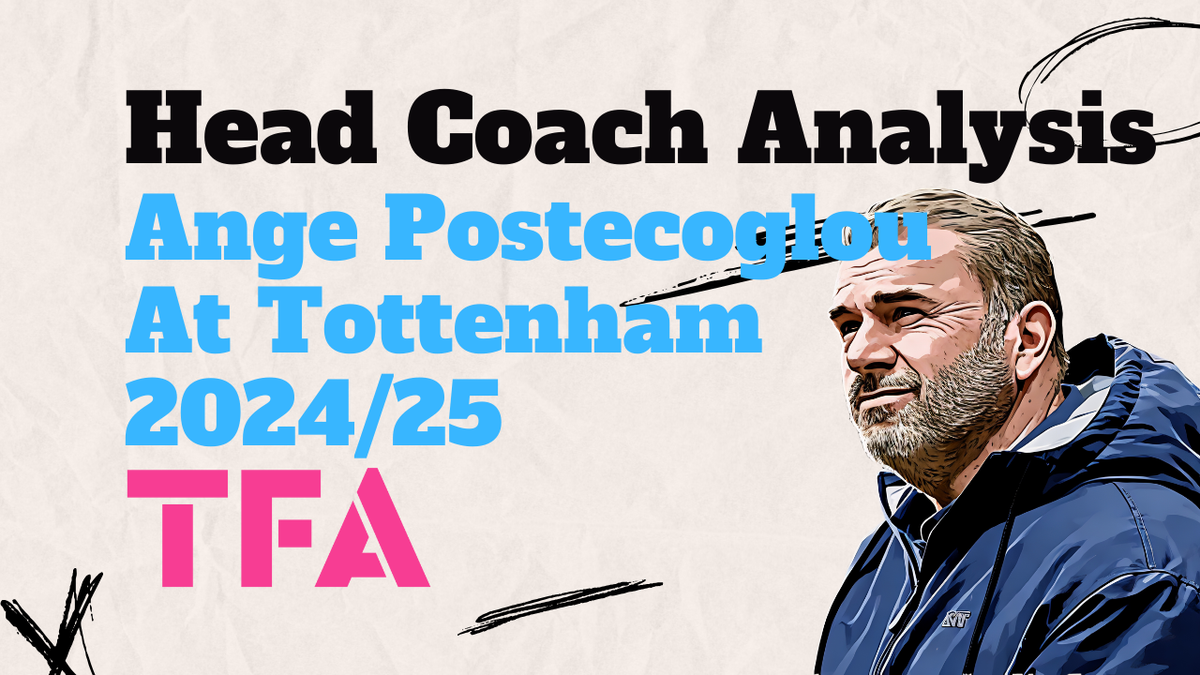
Comments